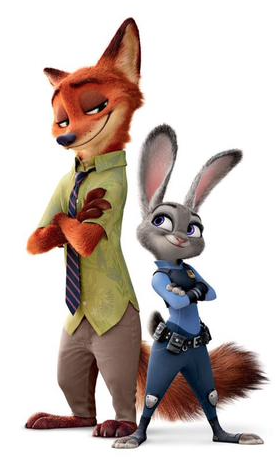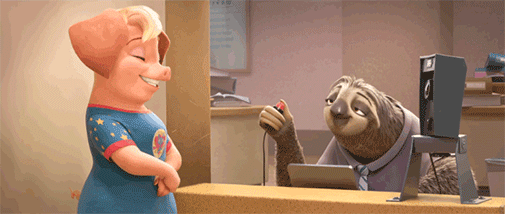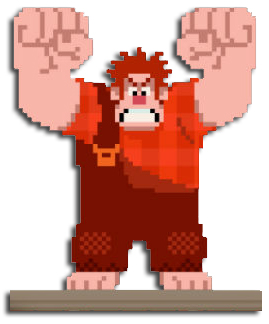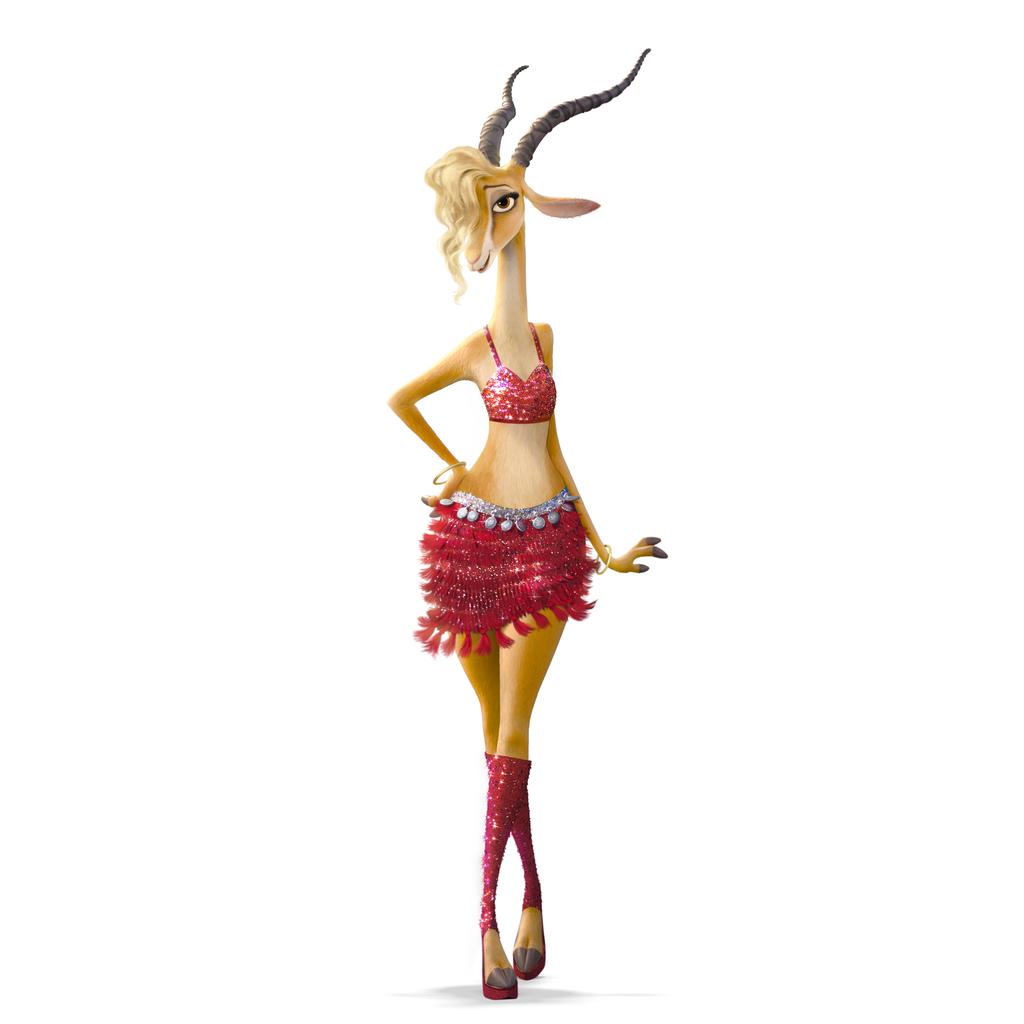 Zootopia gets a lot of its pizazz from the clash of its odd couple leads but behind the scenes things are much more sympatico. When I sat down to interview the director Rich Moore (Wreck-it Ralph) and producer Clark Spencer (Wreck-it Ralph, Bolt, Lilo & Stitch) they weren't so much finishing each other's sentences as they were most definitely reciting from the same page. Rich calls Clark the 'best producer he's ever worked with' and credits him for creating a structure so that the creatives didn't have to worry about the minutae but were kept aware of it to keep them on track.
Zootopia gets a lot of its pizazz from the clash of its odd couple leads but behind the scenes things are much more sympatico. When I sat down to interview the director Rich Moore (Wreck-it Ralph) and producer Clark Spencer (Wreck-it Ralph, Bolt, Lilo & Stitch) they weren't so much finishing each other's sentences as they were most definitely reciting from the same page. Rich calls Clark the 'best producer he's ever worked with' and credits him for creating a structure so that the creatives didn't have to worry about the minutae but were kept aware of it to keep them on track.
Unfortunately the third key member of their team Byron Howard, who the project originated with had bronchitis on the day we met. He'll be long since recovered by Oscar night which will likely be a happy one for the team.
Zootopia is the second project Moore and Clark have done together but when we sat down to speak over coffee the spectre of Wreck-It Ralph 2 hung like a comic cloud overhead because, as they joked, they've got deadlines! The film doesn't open until March of 2018 but that's a very short time in the production lifespan of an animated feature.
 Byron Howard, Clark Spencer, and Rich Moore won the Golden Globe for Zootopia. Will they win the Oscar, too?
Byron Howard, Clark Spencer, and Rich Moore won the Golden Globe for Zootopia. Will they win the Oscar, too?
But for now, the wrap up of the long journey of Zootopia on Oscar night. This Disney fable about diversity and harmonious living has been successful all over the world grossing over a billion dollars globally, the fourth most successful picture of 2016 behind three films that had a built-in sequel advantage (Captain America, Finding Dory, Rogue One).
In other words, it's been quite a spectacular runaway success. Selections from our chat follow...
NATHANIEL R: Rich, Wreck-It Ralph (2012) was obviously your baby. But this one...
RICH MOORE: A different kind of history. Zootopia began five years ago with my co-director Byron, as a love letter to the types of movies that Byron loved from Disney growing up. The talking animal genre: Wind in the Willows, Robin Hood from the 70s -- particularly the ones where they wore clothes and acted like human beings and lived in a world like ours. Directors follow each others movies and are there to gut check.
CLARK SPENCER: It's called the 'story trust.'
RICH MOORE: It's always easiest to give notes on a movie that is not your own.
[Laughter]
RICH MOORE: Nick was the main character for a very long time but there came a point where we realized we should be watching the story unfold through Judy's eyes. It was a major shift and evident [at that point] that Zootopia was a two person job. We were working on Wreck It Ralph 2 so we tabled that and I jumped on with Byron.
CLARK SPENCER: It's amazing to have fresh eyes every day. Once the switch was made a lot of things lined up perfectly.
Well, it takes a village with these movies. There's a ton of people listed under "story by"
RICH MOORE: There's no formula and there were a couple of ways we could have gone. It felt like the right thing to do on this one is to give credit to all of the people.
NATHANIEL: Well, it fits the theme of community given the movie! Maybe my favorite part of the movie, is the journey into Zootopia where you pass all the little regions. I love movies where, as an audience member, you can imagine entirely different but equally enjoyable movies just off to the side of the frame.
But, given our current movie culture, and I don't mean to be crass but was this sequence to set up an expansive franchise because this is major world building here!
MOORE: I share the affinity for that, too.I remember as a kid watching Pinnochio and there was something about the pan across the village where he lived at the beginning. It had these nooks and corners and doorways. And I would think "What's going on behind that door?" There was something about the look of the backgrownds that I'd think "if I went down that alley..."
A big part of the movie is a detective story but as Judy discovers the details of the case deep into the city and show off all the boroughs. We weren't thinking of sequels we were just trying to finish the movie!
SPENCER: And we do so much research to define the different districts, and what the city would be like. There was a ton of effort put into these districts as they had to be the right kind of the right temperatures for the right animals. An air conditioning unit blows cold air into a house but it blows hot air out the house so that creates Sahara Square and Tundra Town. If the cold district is next to the rainforest the snow melt would become part of the rainforest
You only have 90 minutes to tell a story. We could have told a story just about creating this city. It wouldn't be a good story
[Everyone laughs]
SPENCER: Ultimately the train ride became a way to show those environments we worked five years on to set up the story.
Was there a lot of back and forth about which animals Zootopia would include? It seems like the possibilities would have been endless.
RICH MOORE: Especially in the beginning we would talk "What kind of animal is Judy going to be?" We knew it would be a predator and a prey but should their size be different? A rabbit and a bear? We were looking for the biggest contrast we could have. There was a lot of debate about making it a rabbit and a fox who are so similar in size. We debate this stuff forever. But it felt right that it was a fox. We wanted a sly hustler character working outside of the law.
The flip side of that is the DMV scene. That happened immediately. As we were pitching ideas for jobs that animals could do in Zootopia Head of Story Jim Reardonsaid "how about a sloth at the DMV?"
Such a great joke.
RICH MOORE: After we all laughed that was a moment of realization ' That's a really good idea'
But you probably pissed off DMV workers.
RICH MOORE: I'm afraid to go and renew my licence!

CLARK SPENCER: Since the story if about bias, we wanted to play both to stereotypes (like the Sloth) and against them (the elephant who can't remember) so that the audience is always surprised. Once we figured this out it became a tool.
MOORE: We're talking about the gray area, we're not talking about black and white. That was a decision that came from examining the theme and the characters. What is most entertaining and what speaks to the story we're trying to tell.
NATHANIEL R: It's such a beautifully inclusive movie and the critics and audience were so behind its message. I'm not sure how to ask this but the movie became a global phenomenon while the real world went in the opposite direction of fear-mongering! Was that strange for your team?
MOORE: It was really weird. The election was not in full swing when we were making it but the campaigns were building and knowing that we were making a film that was addressing leading by fear and to see those flames being stoked right before our eyes -- personally, it was surprising at first. Maybe it shouldn't be suprirsing because unfortunately discrimination, bias, and prejudice. This is an evergreen topic. But to see it happening in real time, it made as a storyteller really feel emboldened. It made me feel like "this is an important" topic and we need to give it its due and not make it in authentic. We can't have our main character cure racism.
NATHANIEL: Animated films are, generally speaking, popular with audiences. But this one was so enormous, it must have felt like winning the lottery.
SPENCER: It's an incredible thing to be part of a movie that does over a billion at the box office. But what was most satisfying as we travelled around the world was to see that countries embraced the movie for different reasons. When we went to Europe they were looking at it from the viewpoint of the refugees. It was really topical. In China, interestingly, for them it was about a female character leaving the countryside on a train. For them their was a mirror in there because immmigration from the country to the city is happening in such a big way.
MOORE: Everyone sees it through their own prism but at its core it's still the 'fear of the other' and the effects that has on society.

I'm sure you're both thinking of the Oscars. You've been up once before Rich but you haven't won yet.
RICH MOORE: Thanks for reminding us [Laughter]
[Whispers] I don't think you're going to lose this year. On a lighter note for a final question. Was there any animal somebody was pulling for that didn't make it in?
For some reason in the story department they really wanted a goat in the movie. Over and over a goat character would keep showing up. Suddenly there'd be a goat in the scene. Can it be any other animal? So we finally built a goat [by modifying a gazelle] and suddenly everyone is like "I don't think we need a goat."
Sorry goat-lovers! I was pulling for a racoon, personally.
#Zootopia newscasters by region. US/moose, Japan/tanuki, Australia/koala, China/panda, UK/corgi, Brazil/jaguar. pic.twitter.com/KXiXFelWqe
— Ryshat's Corner (@RyshatsCorner) March 6, 2016
MOORE: In the Japanese version we did swap out a moose anchor with a tanuki, which is like a racoon dog
SPENCER: They're very popular in Japan.
They're soooo cute. But this is getting to be a Disney thing. Captain America Winter Soldier did that with the cultural blind spots list he was keeping -- it changed for different markets.

previous interviews | more on Zootopia | more on animated features